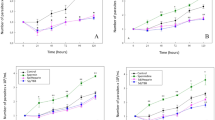Abstract
Epimastigotes of Trypanosoma cruzi showed many filopodium-like projections from the flagellar membrane when incubated in the presence of 100 ng/ml (a concentration which does not interfere with cell motility and viability) phorbol-12-myristate-13-acetate (PMA). PMA is a substance which binds to the membrane-associated protein kinase C. Few of these projections were observed in control parasites. PMA, when added to the interaction medium, significantly increased the attachment of epimastigotes to the surface and their ingestion by resident or activated mouse peritoneal macrophages maintained in vitro. PMA, however, did not interfere with the ingestion of trypomastigotes.
Similar content being viewed by others
References
Araujo-Jorge TC, De Souza W (1984) Effect of carbohydrates, periodate and enzymes in the process of endocytosis of Trypanosoma cruzi by macrophages. Acta Trop (Basel) 41:17–28
Araujo-Jorge TC, De Souza W (1986) Interaction of Trypanosoma cruzi with macrophages: effect of previous incubation of the parasites or the host cells with lectins. Z Parasitenkd 72:153–171
Ashendel CL (1985) The phorbol ester receptor: a phospholipid-regulated protein kinase. Biochim Biophys Acta 822:219–242
Babudieri B, Tomasini N (1962) Fine struttura dei trypanosomi. Parassitologia (Rome) 4:89–95
Berridge MJ, Irvine RF (1984) Inositol triphosphate, a novel second messenger in cellular signal transduction. Nature 312:315–321
Bonaldo MC, Souto-Padrón T, De Souza W, Goldenberg S (1987) Cell Substrate adhesion during Trypanosoma cruzi differentiation. J Cell Biol (in press)
Carvalho TU, De Souza W (1983) Separation of amastigotes and trypomastigotes of Trypanosoma cruzi from cultured cells. Z Parasitenkd 69:571–575
De Souza W, Martinez-Palomo A, Gonzales-Robles A (1978) The cell surface of Trypanosoma cruzi: cytochemistry and freeze-fracture. J Cell Sci 33:285–299
Ellis DS, Ormerod WE, Lumsden WHR (1976) Filaments of Trypanosoma brucei: some notes on differences in origin and structure in two strains of Trypanosoma (Trypanozoon) brucei rhodesiense. Acta Trop (Basel) 33:151–168
Molloy JO, Ormerod WE (1964) A fibril emerging from the posterior region of Trypanosoma rhodesiense. Trans R Soc Trop Med Hyg 58:2–7
Murray HW (1982) Pretreatment with phorbol myristate acetate inhibits macrophage activity against intracellular protozoa. J Reticuloendothel Soc 31:479–487
Nathan C, Nogueira N, Juangbhanich C, Ellis J, Cohn Z (1979) Activation of macrophages in vivo and in vitro. J Exp Med 149:1056–1068
Nishizuka Y (1984) The role of protein kinase C in cell surface signal transduction and tumor promotion. Nature 308:693–698
Parthasarathy R, Eisenberg F Jr (1986) The inositol phospholipids: a stereochemical view of biological activity. Biochem J 235:313–322
Phaire-Washington L, Wang E, Silverstein SC (1980) Phorbol myristate acetate stimulates pinocytosis and membrane spreading in mouse peritoneal macrophages. J Cell Biol 86:634–640
Santo MAV, Pimenta PFP, De Souza W (1986) Effect of phorbol myristate acetate in Leishmania mexicana amazonensis. (Abstract) Mem Inst Oswaldo Cruz Rio de J 81:72
Ulloa R, Torres HN, Esteva M, Tellez-Inon MI (1986) Cyclic AMP-dependent-protein kinase in Trypanosoma cruzi. (Abstract) Mem Inst Oswaldo Cruz Rio de J 81:92
Vickerman K, Luckins AG (1969) Location of variable antigens in the surface coat of Trypanosoma brucei: Nature 244:1125–1126
Warren L (1960) Metabolism of Trypanosoma cruzi, Chagas. I. Effect of culture age and substrate concentration on respiratory rate. J Parasitol 46:529–530
Wright KA, Lumsden WHR, Hales H (1970) The formation of filopodium-like processes by Trypanosoma (Trypanozoon) brucei. J Cell Sci 6:285–297
Zeledon R, Bolanos R, Rojas M (1984) Scanning electron microscopy of the final phase of the life cycle of Trypanosoma cruzi in the insect vector. Acta Trop (Basel) 41:39–43
Author information
Authors and Affiliations
Rights and permissions
About this article
Cite this article
de Carvalho, T.U., de Souza, W. Effect of phorbol-12-myristate-13-acetate (PMA) on the fine structure of Trypanosoma cruzi and its interaction with activated and resident macrophages. Parasitol Res 74, 11–17 (1987). https://doi.org/10.1007/BF00534925
Accepted:
Issue Date:
DOI: https://doi.org/10.1007/BF00534925




